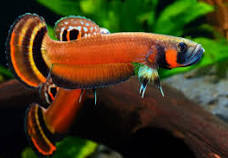Betta Macrostoma 101: Care, Habitat, Breeding
Betta enthusiasts – prepare to be captivated! If you’re searching for a fish that combines exotic beauty with a unique behavioral twist, set your sights on Betta Macrostoma. This dazzling species, known as the Brunei Beauty or Spotfin Betta, goes beyond your typical betta fish experience. Let’s explore what sets them apart and how to create a thriving environment for them in your aquarium.

Credit: aquadiction.com
A Journey into the Wild
Click here for my favorite betta fish care guide
Picture yourself wading through the lush rainforests of Southeast Asia, specifically Brunei and Malaysia. Here, hidden within slow-moving streams, resides Betta Macrostoma. These streams are often stained dark with tannins from decaying leaves and roots, creating an acidic, sheltered environment. Dense aquatic vegetation offers a maze of hiding places. Betta Macrostoma favor warm, soft water with a pH ranging between 4.0 and 6.5. Temperatures between 72-80°F (22-27°C) mimic their natural habitat. It’s important to remember that in the wild, their cautious nature is influenced by potential predators like larger fish and aquatic insects.
A Conservation Concern
The Brunei Beauty carries a “vulnerable” classification on the IUCN Red List, a stark reminder of the environmental pressures they face. Habitat destruction is their primary threat. Once believed extinct, their thrilling rediscovery sparked renewed interest and conservation efforts. Thankfully, Brunei offers some legal protection, offering hope for the future of this unique species.
Peaceful Warriors of the Aquarium
Betta Fish Care Can Be Expensive… Click Here For What You Need to Know To Get It Right…
Ready for a surprise? Unlike the fiery Betta splendens (Siamese Fighting Fish), Betta Macrostoma are peaceful creatures. While males might occasionally stake out their territories, serious injuries are rare. This opens the door to peaceful community setups – provided you choose tankmates carefully!
A Visual Masterpiece
The Brunei Beauty earns its name! Males, reaching about 3 inches (8cm) long, are a dazzling sight. Their elongated fins explode with shimmering reds, blues, and iridescent speckles. True to their name, “macrostoma” translates to “large mouth,” a distinctive feature. Females, while smaller and less vibrantly colored, still possess an understated elegance. When competition arises or during courtship, males dramatically intensify their colors and flare their fins in a breathtaking display that has to be seen to be believed.
Caring for Your Brunei Beauty
Bringing a Betta Macrostoma home involves a commitment to replicating its wild environment. This isn’t a fish for beginners but is deeply rewarding for experienced aquarists. Let’s break down the essentials:
- The Heart of the Habitat: Start with a spacious tank, at least 15 gallons, and absolutely equip it with a tight-fitting lid (these bettas are skilled jumpers!). Mimic their rainforest origins with abundant live plants such as Java Moss, Anubias, and floating varieties to diffuse light. Driftwood branches and caves provide essential hiding spots, reducing stress and encouraging natural behaviors.
- Filtration and Lighting: Choose gentle filtration, like a sponge filter, to avoid creating strong water currents they dislike. Opt for subdued lighting, further recreating the dim conditions of their shaded streams.
- Finding the Perfect Roommates: Tankmates should be selected with utmost care. Small, peaceful species like rasboras, dwarf tetras, or certain barbs make suitable companions. Avoid any fish known for their bright colors, long fins, or nippy tendencies.
- A Feast for a King: Live foods like brine shrimp, daphnia, or bloodworms are their ideal diet but can be supplemented with high-quality frozen options over time. Offer small, frequent meals throughout the day.
- Maintaining Pristine Water: Consistent water quality is essential. Test for pH, hardness, and temperature regularly. Dedicated water changes help replicate the pristine streams they’re accustomed to.
| Category | Details |
|---|---|
| Tank Size | Minimum 20 gallons for a pair; larger for groups. |
| Tank Setup | Dense vegetation, driftwood, caves. Secure lid to prevent escapes. |
| Water Temperature | 68-77°F (20-25°C). |
| pH Level | 4.0-5.7 (soft, acidic water). |
| Water Hardness | 0-90 ppm. |
| Filter | Sponge filter recommended for gentle flow. |
| Lighting | Dim, to simulate shaded natural habitat. |
| Feeding | High-protein diet; prefers live or frozen (brine shrimp, bloodworms). Feed 1-2 times daily. |
| Tank Mates | Compatible with peaceful, small species. Avoid large, aggressive fish or fin nippers. |
| Breeding | Separate breeding tank; high-quality diet for conditioning; male mouthbroods eggs. |
| Water Changes | Bi-weekly changes of 10-20% recommended. |
| Monitoring | Regularly check water parameters; avoid abrupt changes in the environment. |
The Miracle of Mouthbrooding
Witnessing Betta Macrostoma’s breeding behavior is a true aquarist’s privilege! Unlike most betta species, males are mouthbrooders. After a mesmerizing courtship dance, the male carefully gathers the eggs in his mouth and incubates them for approximately two weeks. Here’s what you need for success:
- Setting the Stage: A dedicated breeding tank, smaller in size but mirroring the water conditions of the main setup, is optimal.
- Encouraging Breeding: A nutritious, varied diet encourages breeding behavior.
- The Dance & After: The spawning ritual is a captivating sight, and the male’s attentive care of the eggs is extraordinary. Once hatched, the tiny fry will require specialized care for the first few weeks, including very small foods like infusoria or microworms.
A Treasure Worth Protecting
The Brunei Beauty, Betta Macrostoma, adds a special dimension to aquariums worldwide. Its unique appearance, fascinating behavior, and conservation story are a reminder of nature’s wonder.

